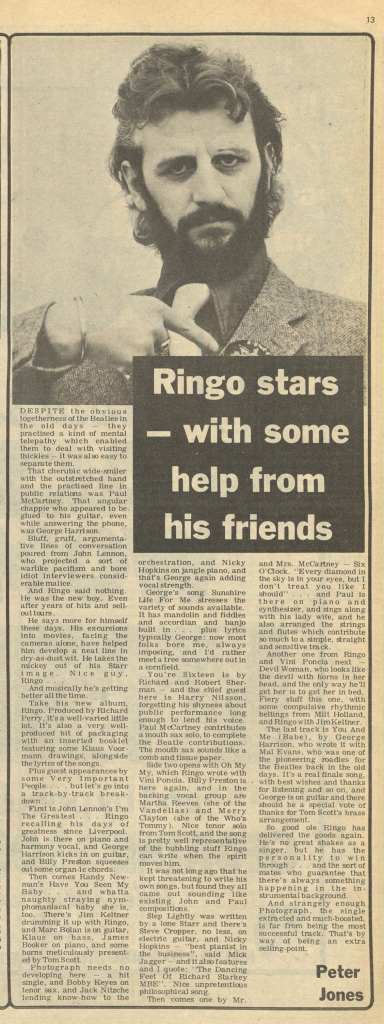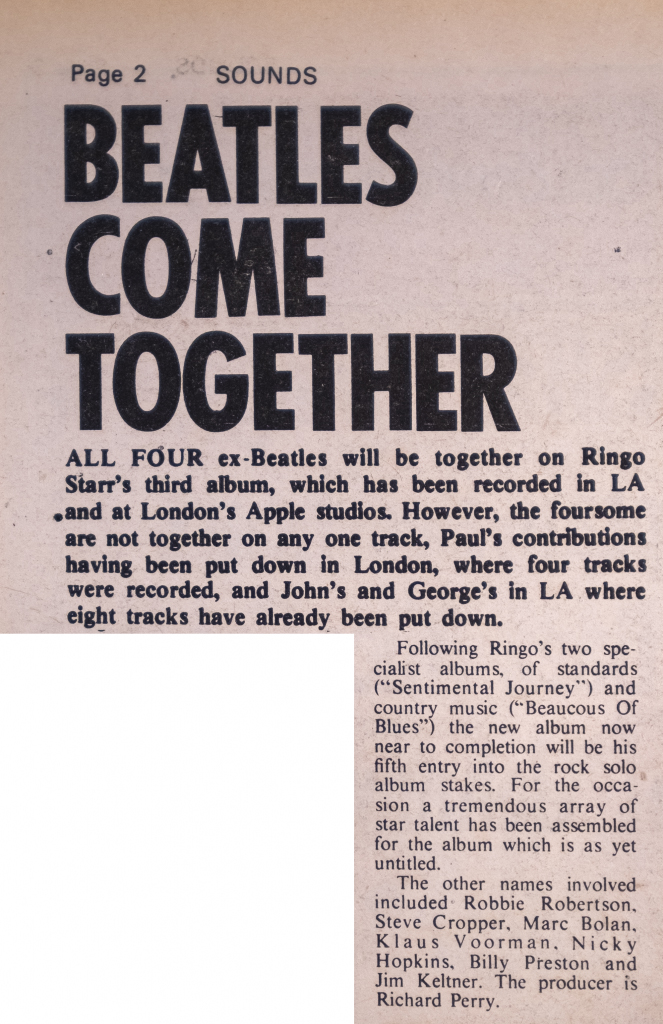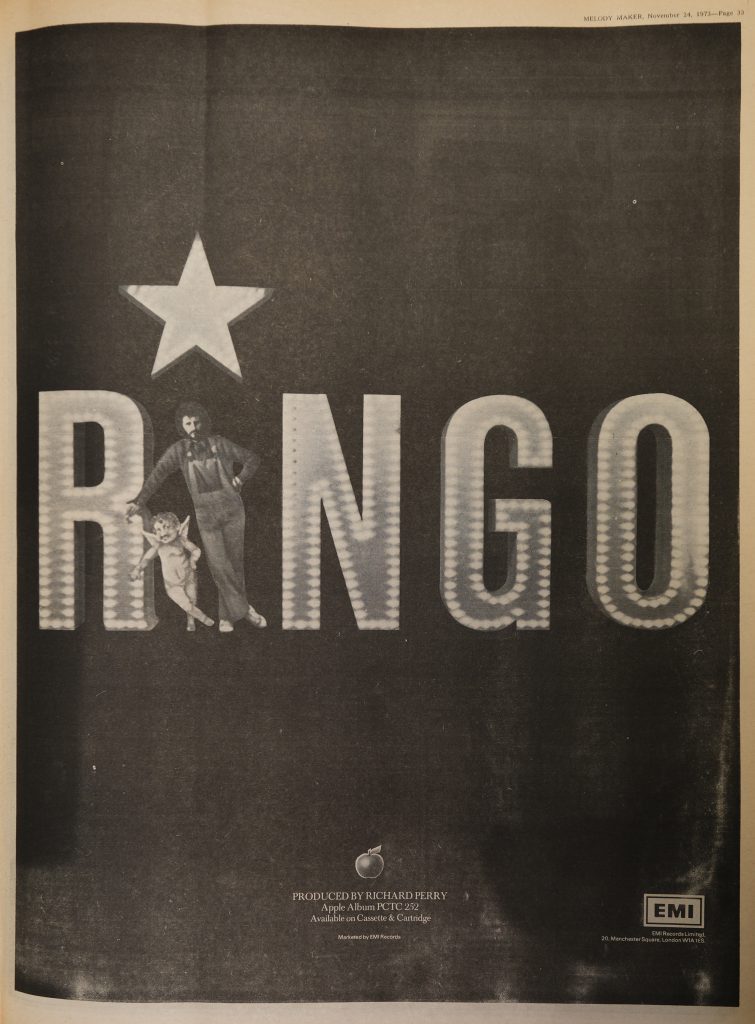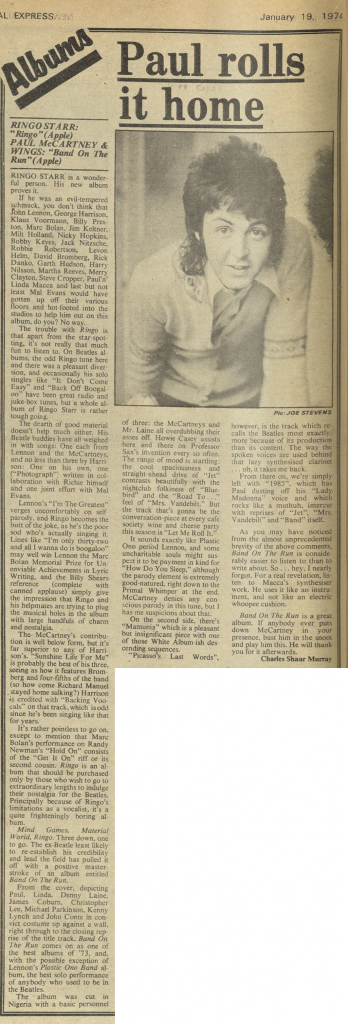- UK release date:
- Nov 23, 1973
- US release date:
- Nov 02, 1973
- Publisher:
- Apple Records
- Reference:
- PCTC 252 (UK) / SWAL-3413 (US)
Timeline
More from year 1973
Related sessions
This album has been recorded during the following studio sessions
Recording "Six O'Clock", "You're Sixteen"
Apr 02, 1973
Spread the love! If you like what you are seeing, share it on social networks and let others know about The Paul McCartney Project.
Hide track details
Track list
Side 1
1.
I'm the Greatest
3:21 • Studio version
2.
Have You Seen My Baby
3:44 • Studio version
3.
Photograph
3:56 • Studio version
4.
Sunshine Life For Me (Sail Away Raymond)
2:45 • Studio version
5.
Written by Bob Sherman, Dick Sherman
2:48 • Studio version • A
- Paul McCartney :
- Kazoo
- Linda McCartney :
- Backing vocals
- Ringo Starr :
- Drums, Lead vocal
- Nicky Hopkins :
- Piano
- Vini Poncia :
- Guitars
- Klaus Voormann :
- Bass
- Jimmy Calvert :
- Guitars
- Harry Nilsson :
- Backing vocals
- Richard Perry :
- Producer
- Bill Schnee :
- Engineer
- Recording :
- March 05-06, 1973
- Studio :
- Sunset Sound Studios, Los Angeles, USA
- Session Overdubs:
- Apr 02, 1973
- Studio :
- Apple Studios, 3 Savile Row, London
- Mixing :
- July 1973
- Studio :
- Sound Labs, Los Angeles, USA
Side 2
1.
Oh My My
4:16 • Studio version
2.
Step Lightly
3:15 • Studio version
3.
Written by Paul McCartney, Linda McCartney
4:06 • Studio version
- Paul McCartney :
- Backing vocal, Piano, String and flute arrangements, Synthesizer
- Linda McCartney :
- Backing vocal
- Ringo Starr :
- Drums, Lead vocal
- Vini Poncia :
- Guitar, Percussion
- Klaus Voormann :
- Bass
- Richard Perry :
- Producer
- Bill Schnee :
- Engineer
4.
Devil Woman
3:50 • Studio version
5.
You And Me (Babe)
4:59 • Studio version
About
From Wikipedia:
Ringo is the third studio album by English musician Ringo Starr, released in 1973 on Apple Records. It peaked at No. 7 on the UK Albums Chart and No. 2 on the Billboard 200, and has been certified platinum by the RIAA. In Canada, it reached No. 1 on the RPM national albums chart.
The album is noted for the participation of all four former Beatles, and for its numerous guest stars, something which would become a signature for Starr on many of his subsequent albums and tours.
Background
Starr released the standards tribute Sentimental Journey and the country and western Beaucoups of Blues in 1970. He issued the singles “It Don’t Come Easy” and “Back Off Boogaloo” over 1971–72, both produced by and co-written with his former Beatles bandmate George Harrison. Both of these singles were big successes and would ordinarily have inspired albums to support them, but Starr declined to follow through, preferring to concentrate on acting during this period. In early 1973, Starr decided that the time was right to begin his first rock solo album. He had already used Richard Perry to arrange one of the tracks on Sentimental Journey, so he asked him to produce the sessions.
Recording
Recording started on 5 March 1973 upon Starr’s arrival in Los Angeles at Sunset Sound Recorders. Sessions were produced by Richard Perry. Starr sent word to his musician friends to help him in his new venture and they all responded positively. Taking part in the sessions were Marc Bolan, four members of The Band (except Richard Manuel), Billy Preston, Klaus Voormann, Nicky Hopkins, Harry Nilsson, Jim Keltner, and James Booker. Additionally, Lennon, McCartney and Harrison all appeared on and composed material for Ringo.
“Photograph” had been written on 15 May 1971 while on a sailing holiday with his wife Maureen, Harrison and Harrison’s wife Pattie Boyd, and Cilla Black. Starr and Harrison wrote the song with input from the others. The song was first recorded in late 1972 with Harrison as producer, during the sessions for Harrison’s Living in the Material World album. The song was remade five months later, produced by Perry for its appearance on Ringo. Harrison and Mal Evans were sharing a living space in Los Angeles when they wrote “You and Me (Babe)” after Evans asked Harrison to add music to a song which he was working on.
Harrison dropped by on the sessions on 10 March to see what kind of material Starr had recorded up to that point, saying that he was “knocked out by what you’ve done”. He returned on 12 March and laid down backing vocals. Starr, John Lennon, and Harrison appear together on Lennon’s “I’m the Greatest”, which was recorded on 13 March. Ten takes of the song were recorded in a session lasting approximately 18 minutes. Both Lennon and Harrison were in Los Angeles for business matters with Capitol Records. Lennon returned to New York on 14 March.
British music magazine Melody Maker reported on 17 March that the session was a Beatles reunion. “Rumours flashed through Los Angeles this week that three of the Beatles have teamed up for recording purposes. John Lennon, George Harrison and Ringo Starr are all in Los Angeles with Klaus Voormann, the bassist rumoured to replace Paul McCartney after his departure from the group.” Also recorded during this month was Randy Newman’s “Have You Seen My Baby?”; it features overdubbed guitar by Bolan which was added at A&M Studios. This group of sessions lasted until 27 March. The next day, Starr and Perry flew to England. More work on the tracks was done at Burbank Studios, The Sound Lab, and Producers’ Workshop. On 16 April, Starr went to Apple Studio in London to record “Six O’Clock” with Paul McCartney, and his wife Linda, as McCartney could not enter the US due to drug arrests. McCartney played synthesizer and piano and sang backing vocals on the track.
After finishing “Six O’Clock”, Starr asked his chauffeur to buy some tap dancing shoes which Starr would use on “Step Lightly”. He then recorded “You’re Sixteen” and “Step Lightly” with Nilsson; McCartney also appears imitating a kazoo on “You’re Sixteen”. This second block of recording sessions lasted until 30 April, and overdubs were added at Sunset Sound Recorders throughout July. The album was mixed at Sunset Sound on 24 July.
Release
According to a report in Billboard magazine in late September 1973, Ringo‘s release was delayed while work was being completed on the album artwork. On 24 September, “Photograph” was released as the album’s lead single in the US, backed by “Down and Out”. Starr filmed a promo clip for the song at his Tittenhurst Park residence, although the film’s only screening was on a single episode of BBC TV’s Top of the Pops, which has since been lost. The single was issued a month later in the UK, on 19 October.
Apple Records released Ringo on 2 November in the US, and on 9 November in the UK. Helped by the international success of “Photograph”, and speculation regarding the former Beatles working together on the same project, the album reached No. 1 in Canada, No. 7 in the UK, and No. 2 on the US Billboard 200 chart, denied the top position by Elton John’s Goodbye Yellow Brick Road. Ringo peaked at No. 1 on America’s other albums charts, however, in Cashbox and Record World. The album was certified gold in America on 8 November and in Britain a month after its release there. Ringo was critically well-received also. Loraine Alterman of The New York Times described it as an “instant knockout … [a] sensational album”. In his review for Rolling Stone, Ben Gerson said that, on one hand, Starr’s limited artistry and the abundance of star guests made the album “rambling and inconsistent”, yet in terms of “atmosphere”, “Ringo is the most successful record by an ex-Beatle. It is not polemical and abrasive like Lennon’s, harsh and self-pitying like Harrison’s, or precious and flimsy like McCartney’s, but balanced, airy and amiable.”
“You’re Sixteen” was released as the album’s second single, backed with “Devil Woman”, in the US on 3 December. In late December, on the 28th, “Photograph” went gold in the US. “You’re Sixteen” acquired gold status in the US on 31 January 1974, and was released in the UK on 8 February, reaching No. 4. In the US, the singles from Ringo “Photograph” and Starr’s cover of “You’re Sixteen” both went to No. 1. On 18 February, “Oh My My” was released as a single only in the US, backed with “Step Lightly”. After the singles became hits, Lennon sent Starr a telegram: “Congratulations. How dare you? And please write me a hit song.”
The original cassette tape and 8-track versions of the album, as well as a small number of early promotional copies of the vinyl album, contained a longer version of “Six O’Clock”. All of the stock copies of vinyl version of the LP, including both the original pressing and the 1981 LP re-release of the album, as well as reissues in various other formats over time, contained the shorter version of the song. The record label on the original stock pressing of the vinyl album incorrectly lists the running time of “Six O’Clock” as 5:26, which may have led some to mistakenly assume that the original pressing contained the long version of the song. The label on the reissued vinyl album correctly lists the running time as 4:06. At the time of release, various reviews and press articles of the day stated that the longer version was “snuck” onto the tape duplicating masters at the last moment. Artwork for a quadrophonic version was produced, but was never released. Additionally, the original artwork lists the second song, written by Randy Newman, as “Hold On” which was later corrected to “Have You Seen My Baby” in following pressings.
When Ringo was reissued for compact disc, the three bonus tracks included on it were all from singles: Starr’s 1971 hit single “It Don’t Come Easy” and its B-side “Early 1970”, as well as the B-side to “Photograph”, “Down and Out”. The CD was released in the UK on 4 March 1991, and in the US by Capitol on 6 May. On some CD reissues “Down And Out” is inserted into the album as the fourth track (between “Photograph” and “Sunshine Life For Me (Sail Away Raymond)”). Also on the CD, “You and Me (Babe)” begins crossfaded over the end of “Devil Woman,” even though the original album had these songs separated by silence. The longer version of “Six O’Clock” was oddly not added as a bonus track to the reissue of this album, but rather to the reissue of Goodnight Vienna. […]




Paul rolls it home
RINGO STARR: “Ringo” (Apple) – PAUL MCCARTNEY & WINGS: “Band On The Run” (Apple)
RINGO STARR is a wonderful person. His new album proves it.
If he was an evil-tempered schmuck, you don’t think that John Lennon, George Harrison, Klaus Voormann, Billy Preston, Marc Bolan, Jim Keltner, Milt Holland, Nicky Hopkins, Bobby Keyes, Jack Nitzsche, Robbie Robertson, Levon Helm, David Bromberg, Rick Danko, Garth Hudson, Harry Nilsson, Martha Reeves, Merry Clayton, Steve Cropper, Paul’n’ Linda Macca and last but not least Mal Evans would have gotten up off their various floors and hot-footed into the studios to help him out on this album, do you? No way.
The trouble with Ringo is that apart from the star-spotting, it’s not really that much fun to listen to. On Beatles albums, the odd Ringo tune here and there was a pleasant diversion, and occasionally his solo singles like “It Don’t Come Easy” and “Back Off Boogaloo” have been great radio and juke-box tunes, but a whole al- bum of Ringo Starr is rather tough going.
The dearth of good material doesn’t help much either. His Beatle buddies have all weighed in with songs: One each from Lennon and the McCartneys, and no less than three by Harri- son: One on his own, one (“Photograph” written in collaboration with Richie himself and one joint effort with Mal Evans.
Lennon’s “I’m The Greatest” verges uncomfortably on self-parody, and Ringo becomes the butt of the joke, as he’s the poor sod who’s actually singing it. Lines like “I’m only thirty-two and all I wanna do is boogaloo” may well win Lennon the Marc Bolan Memorial Prize for Unenviable Achievements in Lyric Writing, and the Billy Shears reference (complete with canned applause) simply give the impression that Ringo and his helpmates are trying to plug the musical holes in the album with large handfuls of charm and nostalgia.
The McCartney’s contribution is well below form, but it’s far superior to any of Harri- son’s. “Sunshine Life For Me” is probably the best of his three, seeing as how it features Bromberg and four-fifths of the band (so how come Richard Manuel stayed home sulking?) Harrison is credited with “Backing Vocals” on that track, which is odd since he’s been singing like that for years.
It’s rather pointless to go on, except to mention that Marc Bolan’s performance on Randy Newman’s “Hold On” consists of the “Get It On” riff or its second cousin. Ringo is an album that should be purchased only by those who wish to go to extraordinary lengths to indulge their nostalgia for the Beatles. Principally because of Ringo’s limitations as a vocalist, it’s a quite frighteningly boring album.
Mind Games, Material World, Ringo. Three down, one to go. The ex-Beatle least likely to re-establish his credibility and lead the field has pulled it off with a positive masterstroke of an album entitled Band On The Run.
From the cover, depicting Paul, Linda, Denny Laine, James Coburn, Christopher Lee, Michael Parkinson, Kenny Lynch and John Conte in convict costume up against a wall, right through to the closing reprise of the title track, Band On The Run comes on as one of the best albums of ‘73, and, with the possible exception of Lennon’s Plastic Ono Band al- bum, the best solo performance of anybody who used to be in the Beatles.
The album was cut in Nigeria with a basic personnel of three: the McCartneys and Mr. Laine all overdubbing their asses off. Howie Casey assists here and there on Professor Sax’s invention every so often. The range of mood is startling: the cool spaciousness and straight-ahead drive of “Jet” contrasts beautifully with the nightclub folkiness of “Bluebird” and the “Road To…” feel of “Mrs. Vandebilt.” But the track that’s gonna be the conversation piece at every cafe society wine and cheese party this season is “Let Me Roll It.”
It sounds exactly like Plastic Ono period Lennon, and some uncharitable souls might suspect it to be payment in kind for “How Do You Sleep,” although the parody element is extremely good-natured, right down to the Primal Whimper at the end. McCartney denies any conscious parody in this tune, but I have my suspicions about that.
On the second side, there’s “Mamunia” which is a pleasant but insignificant piece with one of those White Album-ish descending sequences.
“Picasso’s Last Words”, however, is the track that recalls the Beatles most exactly: more because of its production than its content. The way the spoken voices are used behind that lazy synthesised clarinet …oh, it takes me back.
From there on, we’re simply left with “1985”, which has Paul dusting off his “Lady Madonna” voice and which rocks like a muthuh, intercut with reprises of “Jet”, “Mrs. Vandebilt” and “Band” itself.
As you may have noticed from the almost unprecedented brevity of the above comments, Band On The Run is considerably easier to listen to than to write about. So… hey, I nearly forgot. For a real revelation, listen to Macca’s synthesiser work. He uses it like an instrument, and not like an electric whoopee cushion.
Band On The Run is a great album. If anybody ever puts down McCartney in your presence, bust him in the snoot and play him this. He will thank you for it afterwards.
From New Musical Express – January 19, 1974

Last updated on August 23, 2023

Contribute!
Have you spotted an error on the page? Do you want to suggest new content? Or do you simply want to leave a comment ? Please use the form below!